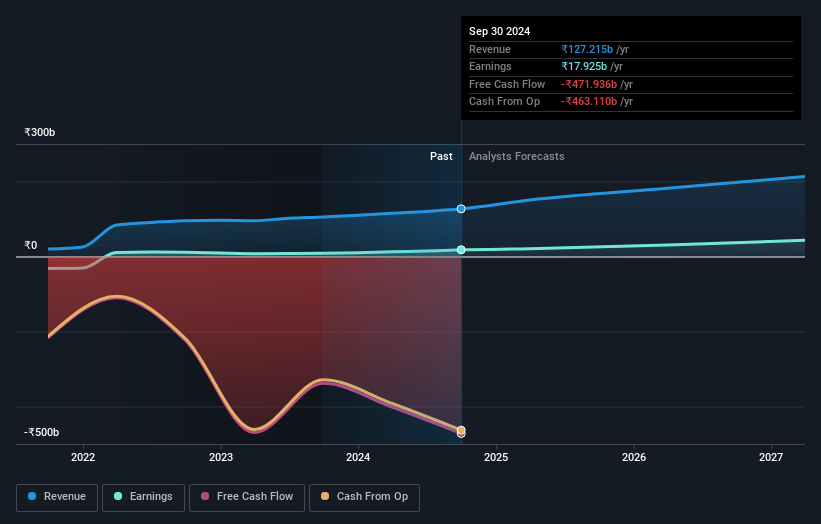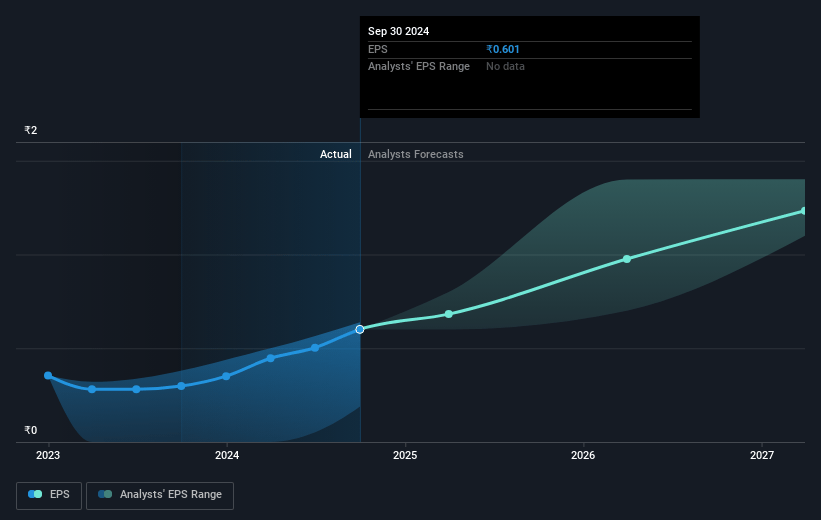Key Takeaways
- Strategic restructuring and reduced deposit interest rates aim to enhance operational efficiency, mitigate costs, and bolster future earnings.
- Focus on retail and SME sectors, along with improved asset quality, is set to positively influence net interest income and future profits.
- Improved asset efficiency, rising profitability, and a better deposit base indicate strong earnings potential and increased revenue stability for YES Bank.
Catalysts
About Yes Bank- Engages in the provision of banking and financial products and services primarily in India.
- The bank's management anticipates reducing RIDF and other mandatory deposits from 8.7% of total assets to below 5% by fiscal 2027. This reduction could potentially decrease interest expenses and improve net interest margins, impacting future earnings positively.
- YES Bank has undertaken a strategic restructuring of business units, aiming to enhance operational efficiency and profitability. This reorganization could lead to lower operating expenses, thereby improving net margins and future earnings.
- The bank has implemented a significant reduction in savings deposit interest rates, which is expected to lower the overall cost of deposits by approximately 20 basis points. This action is anticipated to mitigate net interest margin compression in the near term, supporting future profits.
- Management indicated an expected retail loan growth target of 10% to 12%, primarily focusing on the higher-margin retail and SME sectors, which could enhance the loan yield and contribute positively to net interest income growth.
- YES Bank plans to leverage its increased provision coverage and anticipated recoveries from fully provisioned security receipts to improve asset quality metrics. The recoveries, expected to be around ₹3,000 crores, could augment non-interest income and bolster future earnings.
Yes Bank Future Earnings and Revenue Growth
Assumptions
How have these above catalysts been quantified?- Analysts are assuming Yes Bank's revenue will grow by 9.7% annually over the next 3 years.
- Analysts assume that profit margins will increase from 17.5% today to 27.5% in 3 years time.
- Analysts expect earnings to reach ₹50.8 billion (and earnings per share of ₹1.4) by about April 2028, up from ₹24.5 billion today. However, there is a considerable amount of disagreement amongst the analysts with the most bullish expecting ₹66.5 billion in earnings, and the most bearish expecting ₹40.0 billion.
- In order for the above numbers to justify the analysts price target, the company would need to trade at a PE ratio of 18.3x on those 2028 earnings, down from 23.6x today. This future PE is greater than the current PE for the IN Banks industry at 10.9x.
- Analysts expect the number of shares outstanding to grow by 7.0% per year for the next 3 years.
- To value all of this in today's terms, we will use a discount rate of 14.0%, as per the Simply Wall St company report.
Yes Bank Future Earnings Per Share Growth
Risks
What could happen that would invalidate this narrative?- YES Bank's return on assets (ROA) increased from 0.3% to 0.6% over the fiscal year, indicating improved asset efficiency, which could bolster earnings.
- The bank's net profit increased 92.3% year-over-year, showcasing a significant improvement in profitability which might lead to increased earnings expectations.
- The noninterest income as a percentage of average assets grew from 1.1% to 1.4%, suggesting diversification of revenue streams that could positively impact revenue stability.
- YES Bank's CASA ratio improved to 34.3%, indicating a more stable and lower-cost deposit base, which can enhance net interest margins.
- The bank's efforts in reducing high-cost borrowings and complying with PSL requirements are expected to further reduce costs and improve earnings stability.
Valuation
How have all the factors above been brought together to estimate a fair value?- The analysts have a consensus price target of ₹16.364 for Yes Bank based on their expectations of its future earnings growth, profit margins and other risk factors.
- In order for you to agree with the analyst's consensus, you'd need to believe that by 2028, revenues will be ₹184.8 billion, earnings will come to ₹50.8 billion, and it would be trading on a PE ratio of 18.3x, assuming you use a discount rate of 14.0%.
- Given the current share price of ₹18.42, the analyst price target of ₹16.36 is 12.6% lower. Despite analysts expecting the underlying buisness to improve, they seem to believe the market's expectations are too high.
- We always encourage you to reach your own conclusions though. So sense check these analyst numbers against your own assumptions and expectations based on your understanding of the business and what you believe is probable.
How well do narratives help inform your perspective?
Disclaimer
Warren A.I. is a tool utilizing a Large Language Model (LLM) that ingests data on consensus price targets, forecasted revenue and earnings figures, as well as the transcripts of earnings calls to produce qualitative analysis. The narratives produced by Warren A.I. are general in nature and are based solely on analyst data and publicly-available material published by the respective companies. These scenarios are not indicative of the company's future performance and are exploratory in nature. Simply Wall St has no position in the company(s) mentioned. Simply Wall St may provide the securities issuer or related entities with website advertising services for a fee, on an arm's length basis. These relationships have no impact on the way we conduct our business, the content we host, or how our content is served to users. The price targets and estimates used are consensus data, and do not constitute a recommendation to buy or sell any stock, and they do not take account of your objectives, or your financial situation. Note that Warren A.I.'s analysis may not factor in the latest price-sensitive company announcements or qualitative material.




